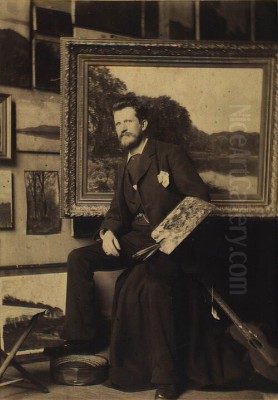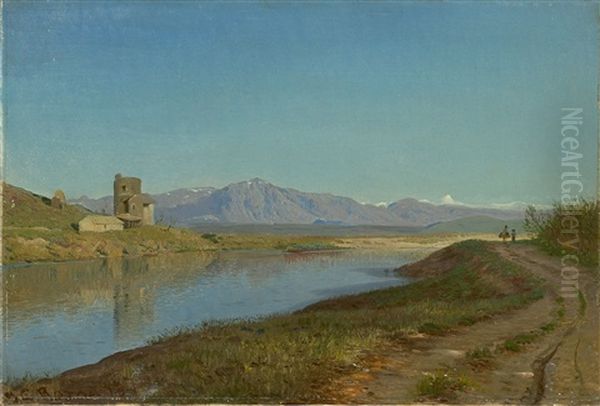
Godfred Christensen stands as a significant figure in the landscape of Danish art history. Spanning a long and productive career from the mid-19th century well into the 20th (1845-1928), he navigated the crucial transition period between the waning national Romanticism of the Danish Golden Age and the burgeoning influence of Realism and Impressionism arriving from France. Born in Copenhagen and passing away in Tibirke, Christensen dedicated his artistic life primarily to landscape painting, becoming renowned for his sensitive depictions of Danish nature, particularly its forests and coastal areas.
His work is characterized by a deep appreciation for the effects of light, color, and atmosphere, capturing the specific moods of the Danish environment. He was not merely a passive observer but an artist who actively synthesized the traditions he inherited with the new artistic currents he encountered, forging a style that held onto a romantic sensibility while embracing a more naturalistic and sometimes impressionistic approach to representation. This unique blend secured his place as one of Denmark's important landscape painters during a dynamic era of artistic change.
Early Life and Artistic Formation
Godfred Christensen's journey into the world of art began early. Born in the Danish capital of Copenhagen in 1845, he displayed a noticeable talent for drawing and painting from a young age. Recognizing this potential, he began receiving formal instruction at the age of just fourteen. His first significant teacher was Frederik Christian Kiærskou (often cited as F.C. Kiærskou), a respected landscape painter of the preceding generation, known for his detailed and somewhat romanticized views of the Danish countryside.
Studying under Kiærskou provided Christensen with a solid foundation in the techniques and aesthetics prevalent in Danish art at the time. This early training undoubtedly instilled in him a respect for careful observation and the tradition of national landscape painting established by figures of the Danish Golden Age like Christen Købke and Johan Thomas Lundbye. In 1860, Christensen took the next logical step, enrolling at the prestigious Royal Danish Academy of Fine Arts in Copenhagen, where he continued his studies until 1867.

During his time at the Academy, Christensen began to specialize, focusing increasingly on forest landscapes. This subject matter would remain central to his oeuvre throughout his career. The Academy years provided him not only with technical skills but also exposed him to the ongoing dialogue within Danish art circles, likely including the legacy of the great landscape painter Peter Christian Skovgaard (P.C. Skovgaard), whose monumental depictions of Danish beech forests were highly influential. Christensen was thus educated within a strong national tradition, yet poised on the cusp of new international influences.
Studies Abroad and the Influence of French Art
A pivotal element in the development of Godfred Christensen's mature style was his experience abroad. Like many ambitious artists of his generation, he sought to broaden his horizons and engage directly with the latest artistic developments, particularly those emanating from France. He undertook study trips, spending significant time in both Rome and Paris. These journeys proved crucial in shaping his artistic vision and technique, pushing him beyond the confines of his academic training.
In Paris, Christensen encountered the revolutionary movements that were challenging traditional artistic norms. He was reportedly influenced by the painters associated with the Barbizon School, often referred to as the "Fontainebleau School" due to their practice of painting outdoors in the Forest of Fontainebleau. Artists like Jean-Baptiste-Camille Corot, Théodore Rousseau, and Charles-François Daubigny championed a more direct, naturalistic approach to landscape, focusing on capturing the fleeting effects of light and atmosphere. Their work likely resonated with Christensen's own burgeoning interest in natural phenomena.
Furthermore, his time in France, particularly during the 1870s, exposed him to the nascent Impressionist movement and what sources refer to as the "Colorism movement." While perhaps not adopting the full broken brushwork technique of Claude Monet or Camille Pissarro, Christensen absorbed the Impressionists' heightened sensitivity to color and light, and their commitment to capturing immediate sensory experience. He began experimenting with ways to integrate these French techniques – the emphasis on light, freer brushwork, and a brighter palette – with the more grounded, detailed tradition of Danish Naturalism he knew from home. His travels to Italy, particularly Rome, also provided new motifs and landscape types, enriching his visual vocabulary.
Mature Career: Depicting the Danish Landscape
Returning to Denmark, Godfred Christensen applied the lessons learned abroad to his primary subject: the Danish landscape. He became particularly known for his depictions of forest interiors, often capturing the dappled sunlight filtering through the leaves of beech trees, a motif deeply embedded in Danish national identity thanks to predecessors like P.C. Skovgaard. However, Christensen's approach often featured a lighter palette and a greater emphasis on atmospheric effects than seen in the earlier Golden Age masters.
His focus was not limited to forests. Christensen also painted numerous scenes along the Danish coasts, with the area around Humlebæk, north of Copenhagen, being a recurring location. These works often capture the specific light conditions of the coast, the interaction of sea and sky, and the human elements within the landscape, such as harbours and boats. He also traveled within Denmark, producing works depicting the landscapes of Jylland (Jutland), showcasing the diversity of the Danish environment.
Throughout his mature career, Christensen remained deeply engaged with the representation of natural light. He showed a particular fondness for capturing the transient moments of the day, especially the warm, evocative light of sunset. His paintings often convey a strong sense of place and mood, balancing objective observation with a subtle emotional resonance that connects back to his Romantic roots. He was a key contributor to the continued tradition of landscape painting in Denmark, adapting it to the changing artistic climate of the late 19th and early 20th centuries alongside contemporaries like Vilhelm Kyhn and the more overtly Impressionist-influenced Theodor Philipsen.
Key Works and Representation
Several works stand out as representative of Godfred Christensen's artistic output and are held in significant collections. One notable example is Humlebæk Havn (Humlebæk Harbour). This painting exemplifies his interest in coastal scenes and his ability to capture the atmosphere of a specific Danish locality. Its presence in the collection of the Statens Museum for Kunst (SMK), Denmark's national gallery in Copenhagen, underscores its importance within the canon of Danish art.
Another significant work mentioned is Tiber with Torre Lazzaroni, painted in 1876. This oil painting (recorded as 52x73 cm) reflects his time spent in Italy. The depiction of the Tiber River in Rome showcases his ability to apply his landscape techniques to foreign scenery, likely focusing on the interplay of light, water, and architecture. Sources indicate a connection between this work, or related studies, and The British Museum in London, which holds prints and drawings by Christensen, suggesting his international reach and recognition.
While perhaps less famous, works like Dickicht am Berghang (Thicket on a Mountainside) represent his dedication to forest scenes. Though specific collection details for this piece might be related to auction records rather than permanent museum holdings, it points to the consistent theme of dense, natural growth in his work. His depictions of Jylland landscapes and the mentioned "Jerusalem paintings" (the context of which requires further clarification but suggests perhaps religious or historically inspired landscapes) further broaden the scope of his known subjects. These works collectively demonstrate his skill in rendering diverse landscapes with his characteristic attention to light and atmosphere.
Artistic Influences and Connections
Godfred Christensen's artistic identity was shaped by a confluence of influences. His foundational training came from F.C. Kiærskou, grounding him in the Danish landscape tradition. He undoubtedly looked towards the established masters of the Danish Golden Age, particularly the great landscape painter P.C. Skovgaard, whose focus on the Danish forest provided a powerful precedent. Christensen absorbed this national heritage, carrying forward the deep connection between Danish art and the native landscape.
His travels brought him into contact with international currents. The Barbizon painters, such as Corot, Rousseau, and Daubigny, offered models for a more naturalistic and atmospheric approach to landscape. The burgeoning Impressionist movement, with figures like Monet, Pissarro, and Alfred Sisley, further pushed his understanding of light and color, even if he didn't fully adopt their stylistic revolution. He synthesized these French influences with his Danish sensibilities.
Within the Danish art scene of his time, Christensen occupied a space alongside other significant figures. While direct collaborations are not documented, he was contemporary with artists pursuing related goals, such as Vilhelm Kyhn, another prominent landscape painter and teacher, and Theodor Philipsen, who more fully embraced Impressionism. He also worked during the period of the Skagen Painters, like Anna Ancher and Michael Ancher, who focused on coastal light and life in a realist vein, and L.A. Ring, a key figure in Danish Realism and Symbolism. Even the distinct atmospheric interiors of Vilhelm Hammershøi belong to the same broad era of Danish art. Christensen's work provides a bridge between the generation of Skovgaard and these later developments.
Art Historical Significance and Reception
In the narrative of Danish art history, Godfred Christensen is primarily valued as a transitional figure. He successfully navigated the shift from the ideals of National Romanticism, which had dominated the first half of the 19th century, towards the more objective and light-focused approaches of Realism and Impressionism that gained prominence in the latter half. His ability to blend elements from both Danish tradition and French innovation gave his work a unique character.
His paintings were well-received during his lifetime, exhibited regularly (including mentions of exhibitions as early as 1873), and earned him considerable recognition within Denmark. He was seen as a painter who could capture the quintessential Danish landscape with sensitivity and skill, updating the tradition for a new era. His work was praised for its handling of light, color, and atmosphere, effectively conveying the moods of nature. He played a role in disseminating French artistic ideas within Denmark through his own adapted style.
However, his position as a transitional figure also led to some criticism. Some later commentators, perhaps viewing his work through the lens of more radical modernist developments, occasionally found his paintings to prioritize pleasing surface effects over deeper structural analysis or detailed rendering. This critique suggests that while accomplished in capturing atmosphere and overall impression, his work sometimes stopped short of the rigorous detail of earlier masters or the revolutionary techniques of the full-fledged Impressionists. Nevertheless, his importance lies in his role as a bridge, maintaining the strength of the Danish landscape tradition while thoughtfully incorporating new European artistic ideas.
Later Life and Legacy
Godfred Christensen enjoyed a remarkably long life and career, continuing to paint into the 20th century. He passed away in 1928 in Tibirke, a coastal area north of Copenhagen that he had often depicted, at the venerable age of 84. His lifespan allowed him to witness significant transformations in the art world, from the end of the Golden Age to the rise of modernism.
His legacy rests primarily on his contribution to Danish landscape painting. He maintained the genre's prominence in Danish art during a period when other subjects and styles were emerging. His dedication to capturing the specific qualities of Danish nature – its forests, coasts, and light – resonated with national sentiment and artistic tradition. His synthesis of Danish Naturalism with elements learned from French art provided a pathway for subsequent artists seeking to modernize their approach without completely breaking from their heritage.
Sources suggest he may have influenced later artists, mentioning figures like L. K. Christensen (requiring further verification regarding specific relationship or impact). More broadly, his consistent output and respected position ensured that landscape painting, infused with a greater sensitivity to light and atmosphere influenced by Impressionism, remained a vital part of the Danish art scene. Godfred Christensen is remembered as a skilled, sensitive, and important painter who skillfully navigated the artistic currents of his time, leaving behind a rich body of work celebrating the Danish landscape.